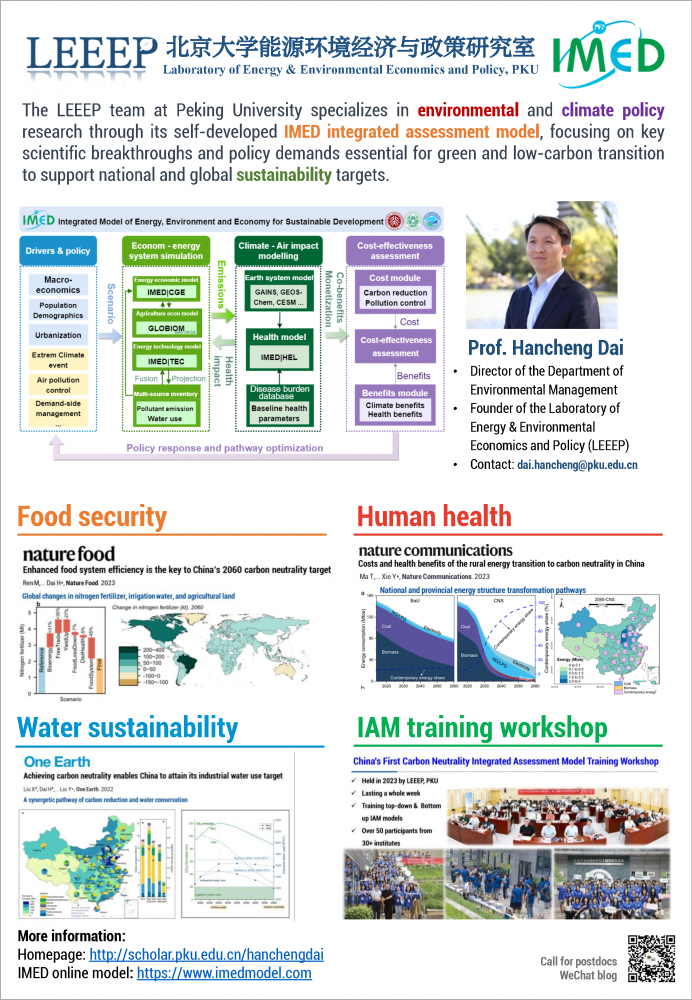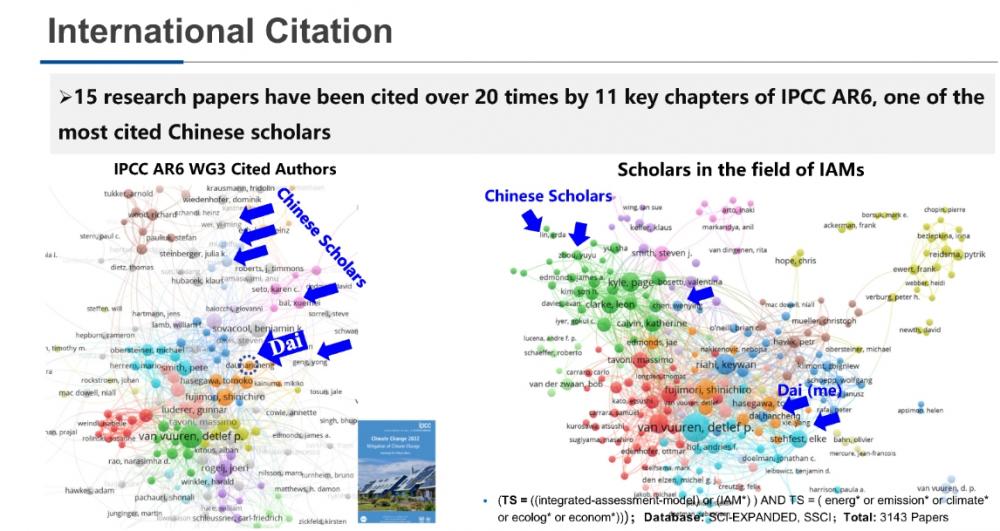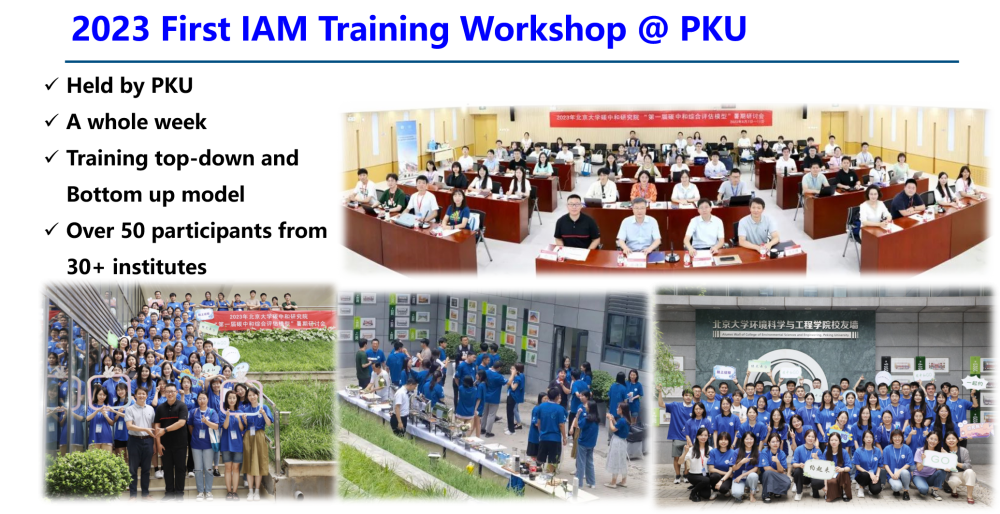The Laboratory of Energy & Environmental Economics and Policy (LEEEP) at Peking University specializes in environmental and climate policy research through its self-developed IMED integrated assessment model, focusing on key scientific breakthroughs and policy demands essential for green and low-carbon transition to support national and global sustainability targets.
PI: Hancheng Dai (戴瀚程)
Dr. Dai is Associate Professor with Tenure and Director of the Department of Environmental Management in the College of Environmental Sciences and Engineering at Peking University. He is also a joint appointment research fellow of the Institute for Global Health and Development and the Institute of Area Studies at Peking University. More information click here.
LEEEP's research focuses on green & low-carbon transformation and human & planetary health at the local, national and global scales. By developing and applying the state-of-the-art integrated assessment model (The IMED Model), key questions are explored on the mitigation costs of achieving ambitious climate targets and their co-benefits on improvements in air pollution, human health and resource efficiency. The findings from integrated assessment could then provide scientific support for policy making to find out how the society could achieve carbon emission peak, carbon neutrality and sustainable development goals. Introduction to the IMED model is available here in Chinese and English. Meanwhile, LEEEP launched China's First Carbon Neutrality Integrated Assessment Model Workshop held at Peking University to help cultivation for dual-carbon comprehensive talents (Report link: China's First Carbon Neutrality Integrated Assessment Model Workshop Held at Peking University).
Key take-aways about LEEEP Team:
- Professional: Full-time model development team of 11 PhD students and 6 postdocs, who develop top-down economic bottom-up technology model
- Young but experienced: A group with nearly 15 years of model development & application experiences
- Productive and high-quality: published over 100 IAM model-based papers on SCI journals, including Nature Food, One Earth etc.
- Rich project management experiences: fundraising more than 4 mil. USD in the past 7 years, including China-Irish (UCC), China-Austria (IIASA) bilateral projects funded by NSFC and MOST
- Active in international collaboration via UNEP GEO7 (with PBL & AIM teams), China-EU modelling dialogue (with PIK & IIASA), bilateral projects (with IIASA etc.)

Figure: Overview of LEEEP Research Activity
The research of the LEEEP group have received close attention at home and abroad. In recent years, based on the IMED integrated assessment model system, LEEEP members have published relevant papers in Nature Food, Nature Communications, One Earth, Global Environmental Change, ES&T and other mainstream journals. With the support of national key R&D projects, LEEEP evaluated the cost-benefit analysis studies on air pollution control in China published in the past 20 years, and sorted out the common methods, core findings and evolution in this field (Report link: IMED research | Literature review on cost-benefit assessment of China’s air pollution control policies). The latest research on model assessment has been tracked and reported by the EU Climate Change Assessment Model Progress for many years.
LEEEP research supported the key contents of multiple chapters in the latest Sixth Assessment Report (AR6) released by the Intergovernmental Panel on Climate Change (IPCC) in 2022. 15 research papers were cited by the IPCC AR6 report more than 20 times (Report link). Relevant papers cover important issues such as green and low-carbon transformation and policy emission reduction effects, economic costs and co-benefit assessment. The cited papers run through 11 key chapters of the reports of the Working Group I and Working Group III (Report link: LEEEP research | List of papers by the research team supporting IPCC AR6), such as Chapter 2 (Emission Trends and Driving Factors), Chapter 3 (Long-term Mitigation Path), which focus on the overall analysis of the socio-economic system, Chapter 4 (mitigation and development paths in the near and medium term), Chapter 5 (Social service needs for mitigation), and Chapter 6 (Energy System), Chapter 10 (Transportation Sector) and Chapter 11 focusing on key high energy-consuming sectors (Industrial sector). In addition, LEEEP also led the CGE multi-model comparison activity of the China Energy Model Forum (CEMF), which improved the transparency and comparability of domestic models (Report link: IMED cooperation | China multi-model comparison: general equilibrium analysis of carbon tax).


----------More Information-------------
- Homepage: http://scholar.pku.edu.cn/hanchengdai
- Personal CV: https://www.jianguoyun.com/p/DblxyYoQlL7CBhiiz3M
- About LEEEP: https://mp.weixin.qq.com/s/-yxEGe_pqD70uO-e6fNpPQ
- About IMED: https://mp.weixin.qq.com/s/jCZGZ0ZVFtSFmZQlDjc2nw
- IMED Book in Chinese: https://www.jianguoyun.com/p/DVrcIwsQlL7CBhjE13M
- IMED Book in English: https://www.jianguoyun.com/p/DZnI8a8QlL7CBhi913M
- LEEEP Research | A Multi-model Comparison of Carbon Tax Policy in China: https://mp.weixin.qq.com/s/u3rxqmSJKXDdVVvJ31qTmg
- LEEEP Research | One Earth: Achieving carbon neutrality enables China to attain its industrial water use target:https://doi.org/10.1016/j.oneear.2022.01.007
- LEEEP Research | Nature Food: Enhanced food system efficiency is the key to China’s 2060 carbon neutrality target: https://www.nature.com/articles/s43016-023-00790-1
- LEEEP Research | Nature Communications: Costs and health benefits of the rural energy transition to carbon neutrality in China: https://www.nature.com/articles/s41467-023-41707-7
- LEEEP Paper cited by IPCC AR6: https://mp.weixin.qq.com/s/a8-SKPYmEBGRBdu8dyqPCg
